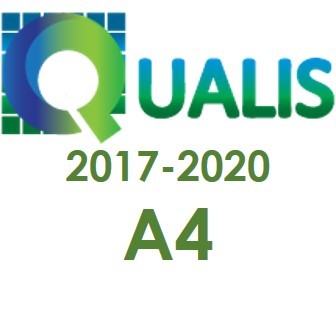Sensibilidade a posteriori de um modelo de Captura-recaptura aplicado a estimação da frota de veículos
Palavras-chave:
Estimativas. Modelo. Bayesiano. Frota. Veículos.Resumo
Este artigo tem como objetivo estimar o tamanho da frota de veículos automotores que frequentam os estacionamentos do Campus Sede da Universidade Federal do Oeste da Bahia. A hipótese é de que o tamanho da frota seja diferente para cada um dos três períodos de funcionamento da instituição. Adotamos um modelo bayesiano de captura-recaptura múltipla e monitoramos a sensibilidade a posteriori do tamanho da frota, considerando distribuições a priori informativas e não informativas. Os resultados bayesianos mostraram-se semelhantes às estimativas clássicas quando adotamos prioris não informativas e revelaram que a frota de veículos é maior para o período vespertino. Para carros obtivemos: , e , e para motocicletas obtivemos , e , nos períodos matutino, vespertino e noturno, respectivamente.
Downloads
Referências
BAILEY, N. T. J. On estimating the size of mobile populations from recapture data. Biometrika, Oxford, v. 38, p. 293-306, 1951.
BASU, S.; EBRAHIMI, N. Bayesian capture-recapture methods for error detection and estimation of population size heterogeneity and dependence. Biometrika, Oxford, v. 88, n. 1, p. 269–279, 2001.
BEST, N.; COWLES, M. K.; VINES, K. CODA - Convergence Diagnosis and Out-put Analysis Software for Gibbs Sampling Output. Biostatistics, Unit MRC, Cambridge, Inglaterra, 1996.
BUSSAB, W.; BOLFARINE, H. Elementos de amostragem. São Paulo: Edgar Blucher, 2005.
CASTLEDINE, B. A. Bayesian analysis of multiple-recapture sampling for a closed population. Biometrika, Oxford, v. 68, n. 1, p. 197-210, 1981.
CHAPMAN, D. G. Some properties of the hypergeometric distribution with applications to zoological sample censuses. Publications in Statistics, University of California, v. 1, n. 7, p. 131-60, 1951.
CHAPMAN, D. G. The estimation of biological populations. The Annals of Mathematical Statistics, Ann Arbor, Michigan, v. 25, n. 1, p. 1-15, 1954.
GELMAN, A.; RUBIN, D. Inference from iterative simulation using multiple sequences. Statistical Science, Ann Arbor, Michigan, v. 7, n. 4, p. 457-511, 1992.
GEORGE, E. I.; ROBERT, C. P. Capture-recapture estimation via Gibbs sampling. Biometrika, Oxford, v. 79, n. 4, p. 677-683, 1992.
HASTINGS, W. K. Monte Carlo Sampling methods using Markov Chains and Their Applications. Biometrika, Oxford, v. 57, n. 1, p. 97-109, 1970.
HU, M. XU, C. WANG, J. Spatiotemporal analysis of men who have sex with men in mainland China: social app capture-recapture method. JMIR mHealth uHealth, Michigan, v. 8, nº 1, 2020.
LAPLACE, P. S. Sur les naissances, les mariages et les morts. Histoire de L’Académie Royale des Sciences, Paris, p. 693, 1786.
LINCOLN, F. C. Calculating waterfowl abundance on the basis of banding returns. U.S. Departament of agriculture, Washington, v. 118, p. 1-4, 1930.
LIU, Y. ZHU, L. LIU, G. & LI, H. Abundance estimation with a categorical covariate subject to missing in continuous-time capture-recapture studies. Communications in Statistics: Theory and Methods, Philadelphia, p. 4919-4928, 2020.
OLIVEIRA, J. O.; BUENO-FILHO, J. S. S. Dinâmica da frota de veículos que estacionam no centro de Lavras, M.G. Revista Ciência e Agrotecnologia, Lavras, v. 28, n. 5, p. 1135-1143, 2004.
ORGANIZAÇÃO DAS NAÇÕES UNIDAS. Transformando o nosso mundo: a agenda 2030 para o desenvolvimento sustentável. Resolução A/RES/70/1 [internet]. Nova Iorque: UN; 2015. Disponível em: https://nacoesunidas.org/wp-content/uploads/2015/10/agenda2030-pt-br.pdf. Acesso em: 02 abril. 2024.
PAULA, M. Um enfoque Bayesiano do modelo de captura-recaptura na presença de covariáveis. Dissertação (Mestrado em estatística) ¬– Universidade Federal de São Carlos, São Carlos, 2006.
PETERSEN, C. G. J. The yearly immigration of young plaice into Limfjord from the German sea, etc. Report of the Danish Biological Station, Copenhague, v. 6, n. 1, p. 1-48, 1986.
PEZZOTT, G. L. M. Modelos Espaciais de captura-recaptura para populações abertas. Tese (Doutorado em Estatística) – Universidade Federal de São Carlos, 2018.
PEZZOTT, G. L. M., SALASAR, L. E. B., LEITE, J. G., LOUZADA, F. A note on identifiability and maximum likelihood estimation for a heterogeneous capture-recapture model. Communications in Statistics - Theory and Methods, Philadelphia, v. 49, 2020.
R Core Team (2021). R: A language and environment for statistical computing. R Foundation for Statistical Computing, Vienna, Austria. Disponível em https://www.R-project.org/. Acesso em: 04 abril. 2024.
SALASAR, L. E. B.; LEITE, J. G.; LOUZADA, F. On the integrated maximum likelihood estimators for a closed population capture-recapture model with unequal capture probabilities. Statistics, London, England, v. 49, p. 1204-1220, 2015.
SALASAR, L. E. B.; LEITE, J. G.; LOUZADA, F. Likelihood-based inference for population size in a capture-recapture experiment with varying probabilities from occasion to occasion. Brazilian Journal of Probability and Statistics, Durham, North Carolina, USA, v. 30, p. 47-69, 2016.
SCHNABEL, Z. E. The estimation of the total fish population of a lake. American Mathematics Monthly, Washington DC, USA, v. 45, p. 348-52, 1938.
SEBER, G. A. F. The Effects of Trap Response on Tag Recapture Estimates. Biometrics, Washington, v. 26, p. 13-22, 1970.
SEBER, G. A. F. The estimation of animal abundance and related parameters. Charles Griffin and Company Ltd, London, v. 4, p. 130-31, 1982.
SEKAR, C. C.; DEMING, W. E. On a method of estimating birth and death rates and the extent of registration. Journal of the American Statistical Association, United States, v. 44, n. 245, p. 101-115, 1949.
SILVA, C. R. de O. Metodologia e organização do projeto de pesquisa: guia prático. Editora CEFET, Universidade Federal do Ceará, 2004.
SMITH, A. F. M.; ROBERTS, G. O. Bayesian Computation via the Gibbs Sampler and Related Markov Chain Monte Carlo methods. Journal of the Royal Statistical Society, London, v. 55, n. 1, p .3-23, 1993.
SMITH, P. J. Bayesian analysis for a multiple capture-recapture model. Biometrika, Oxford, v. 78, n. 2, p. 399-407, 1991.
WANG, X. Bayesian Analysis of Capture-recapture Models. Ph.D, Dissertation (Doctor of Philosophy) – University of Missouri, Columbia, 2002.
WITTES, J. T. Applications of a multinomial capture-recapture model to epidemiological data. Journal of the American Statistical Association, United States, v. 69, n. 345, p. 93-7, 1974.
WITTES, J. T.; COLTON, T.; SIDEL, V. W. Capture-recapture methods for assessing the completeness of case ascertainment when using multiple information sources. Journal of Chronic Diseases, Atlanta, GA, USA, v. 27, n. 1 p. 25-36, 1974.
WITTES, J. T.; SIDEL, V. W. A generalization of the simple capture-recapture model with applications to epidemiological research. Journal of Chronic Diseases, Atlanta, GA, USA, v. 21, n. 5, p. 287-301, 1968.
ZACHARIAS, H. P. Aplicação do algoritmo Gibbs sampling no processo de captura-recaptura. Dissertação (Mestrado em estatística) – Universidade Federal de São Carlos, São Carlos, 2000.
Arquivos adicionais
Publicado
Como Citar
Edição
Seção
Licença
Copyright (c) 2024 Revista Brasileira de Iniciação Científica

Este trabalho está licenciado sob uma licença Creative Commons Attribution-NonCommercial-ShareAlike 4.0 International License.




